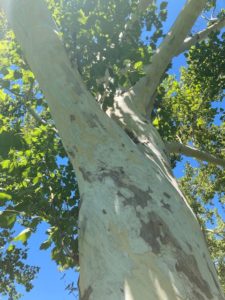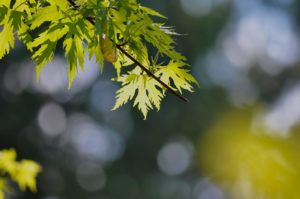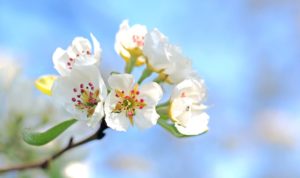Blast | September 16, 2022
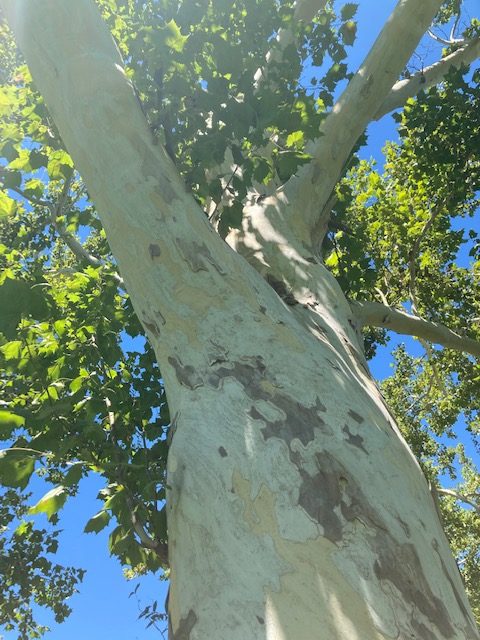
“Three Trees” by Sarah Gorham
BLAST, TMR’s online-only prose anthology, features prose too vibrant to be confined between the covers of a print journal. In “Three Trees” essayist and poet Sarah Gorham gives us three evocative vignettes, across a decades-long span, of the presence and power of nature in our human lives.
Three Trees
Sarah Gorham
In my late teens, I lived close to Washington’s C & O canal, where I often walked along the towpath with my boyfriend, Rob. An enormous sycamore hung over the water, a Methuselah among the nearby saplings and, because of its rotten heartwood, completely hollowed out. And yet it was very much alive, with many branches of healthy foliage. A clever somebody had nailed scrap two-by-fours to it, creating a kind of ladder inside the tree. It extended to a knothole thirty feet up, where a person could peer out at the surrounding woods with the Potomac River beyond.
A sycamore’s skin is rather like sunburn: shock white to begin with, then brown and peeling in irregular patches. Its bark is too rigid to stretch, so as the tree grows, it flakes or sheds—something common to all trees, but not usually so visibly. Sycamores like their soil wet and can be gargantuan. One, in Wabash County, Illinois, measured sixteen feet in diameter and 168 feet tall. Another hollowed tree in Virginia served as a home, sheltering a settler and his two sons for nearly all of 1744. It sounds like a fairy tale, but it’s true. Imagine their rough-hewn table and little stools and the thin blankets they slept on, freezing in the winter, cool in the summer. Imagine their diet of deer meat and squirrel, pawpaw and berries.
Inside the tree, I felt various sensations: the tickle of ants, the disconcerting brush of spiderwebs, the irrational fear that my weight would cause the tree to fall, crushing me and the tree. After a while, there was only the dense quiet like an anechoic chamber. I was cushioned, cared for. I was crawling back into my mother’s womb, which was lined with humus rather than blood and amniotic fluid. And since I was at the peak of my estrogen cycle, I sensed something sexual too, as if I were a seed, swimming toward that egg in the sky.
Down the towpath was a small clearing in the woods, set back from the canal and a good distance from the road. Here, Rob and I waited until dark, trading slugs of lukewarm Mateus wine and, at low volume, listening to rock on his transistor radio. We made sure there were no stargazers or park rangers or cops. We had no cell phones, so there were no anxious calls from our mothers. We smoothed out a sleeping bag, kissed deeply for a long time, then stripped from the waist down and climbed into our first all-the-way sexual encounter. It was awkward, not the ecstatic experience I expected. Nothing like being inside that tree.
A year later, the sycamore was deemed a hazard to bikers and walkers, brought down piece by portable piece, and hauled away. It was disheartening to come across the stump—the towpath coated with shavings, twisted bark, and stray twigs.
And by then, the boy I loved so much had broken my heart too. After months of silence, he shoved a piece of notebook paper into our mailbox, containing only three words: How’s yer face? I said it aloud. It was the raspy sound of a saw.
Side by side on a red leather couch, with a laptop on the coffee table and a movie streaming, they really could be connected at the hip—his hand on her knee hinting at sex, her hands in her armpits, implying, Not now. They are silver maple and white oak, like the conjoined trees in their front yard—an unusual occurrence in the natural world (“hugging trees” tend to be of the same type). How does this happen? Perhaps a seed from one tree imbeds in a decaying patch on the other. More likely, their sway in the wind gradually abrades the bark on each trunk, the cambium and roots grow together, and, decades later, there’s something foresters called “gemels,” from the Latin for “twins.”
She calls the silver maple, a jittery species that grows too quickly, its leaves toothed, flashy on the underside, silver in the sun or rain. Though its limbs are prone to breakage, the tree is popular with impatient people who want their shade now.
He’s more white oak. Look at those sumptuous leaf lobes, the edges entire, glossy, and smooth, like a double-fingered hand. His are, by the way, a photographer’s dream, especially the fingernails, with their matte finish, soft like alabaster. She strokes them jealously and then fists her own fingers so the nails can’t be seen.
We wonder which tree is dominant, which was there first, which has the wider root system? Were they always interconnected, and, if so, when did the inosculation begin? Was one tree hungrier or thirstier? Was the abrasion quick or painfully slow? It looks like the maple shot up fast and the other took some time, its trajectory forced to the side. Near the base, the oak is wrapped halfway around the maple’s trunk as if holding on for dear life.
They snuggle on the couch; his arm and right shoulder overlap hers, a heavy leg pressing till she pushes him away. But his hand always creeps back, aiming for the knee/bedroom. Time, she thinks, to take in some air, a reconnaissance lap around the living room, or rummage in the cupboard for something to eat—peanuts in the shell or extra-crispy potato chips, until he barks, “What are you doing? Can’t you stay put?”
Alas, as it happened, a violent microburst tore down the two trees-that-were-one, detritus fanning out over three front yards. The upper branches were thrown in a chipper, the thicker ones chopped into a year’s worth of firewood. Once the stumps were exposed, it was clear that the trees had remained largely unique. Not visible: a hundred years of entanglement, of roots, still feeling their way through the dark.
(“Blossom,” Sculpture by Wolfgang Buttress)
The Z-shaped entrance to the gallery is hung with black curtains such that she must take a right, then a left turn into what feels like total darkness, hands outstretched to avoid hitting a wall. But gradually she adjusts; transitional sunglasses dissolve to clear, and she soon becomes aware of two dim pools of light hovering over a large three-dimensional cube. Inside are many other glass cubes, threaded with tiny blue and gold lights. At first, she thinks of a right-angled honeycomb, a model for a parking garage, or futuristic skyscraper.
But here is something else, an image trapped between the panes of glass. It is an etching of the original Bramford apple tree, born in Nottingham, England, now roughly two hundred years old and beset with a honey fungus. In the making of this sculpture, she reads, accelerometers are attached to the roots and trunk of the flowering Bramford and her progeny. The instruments are sensitive enough to pick up ongoing vibrations. The tree in its present form is scanned into three dimensions, and minuscule, cast-out signals are recorded, then sent along to the gallery. It’s hard to believe but true: trained scientists can discern insect and bird activity, as well as wind, passing cars, and visitors walking around the site. And there’s music too—a guitar, dissonant harp, and sawing cello, all in a meandering minor key.
The etching surfaces and falls back, swells and sinks— rhythmically, as if the tree were breathing. It’s likely, she guesses, that people over sixty would sympathize with the tree’s struggle to be seen, healed, and definitively remembered. The word “last gasp” comes to mind. There are no chairs or benches in the gallery. But sliding to the floor and forcing her legs into a half lotus, she begins to experience an ethereal relaxation, a feeling like egg whites floating languidly in a rich chicken broth. Is this assurance, that the worst of dying will end in peace?
***
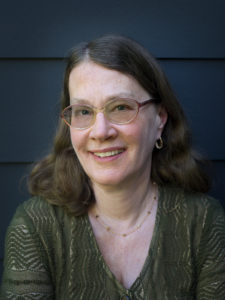 Sarah Gorham is a poet and essayist, most recently the author of Alpine Apprentice (2017), which made the short list for 2018 PEN/Diamonstein Award in the Essay and Study in Perfect (2014), selected by Bernard Cooper for the 2013 AWP Award in Creative Nonfiction. Both were published by University of Georgia Press. Gorham is also the author of four collections of poetry—Bad Daughter (2011), The Cure (2003), The Tension Zone (1996), and Don’t Go Back to Sleep (1989). Other honors include grants and fellowships from the National Endowment for the Arts, three state arts councils, and the Kentucky Foundation for Women. Media coverage. Her work has appeared in Bomb, Kirkus, Salon, NPR, Publishers Weekly, Agni, Diagram, Utne Reader, Slate, Library Journal, Shelf Unbound, The Nation, Real Simple, Missouri Review, and more. She is co-founder and editor-in-chief at Sarabande Books, an independent nonprofit literary publisher, now celebrating its twenty-eighth anniversary. The press was selected as the inaugural winner of the AWP Small Press Publisher Award in 2013.
Sarah Gorham is a poet and essayist, most recently the author of Alpine Apprentice (2017), which made the short list for 2018 PEN/Diamonstein Award in the Essay and Study in Perfect (2014), selected by Bernard Cooper for the 2013 AWP Award in Creative Nonfiction. Both were published by University of Georgia Press. Gorham is also the author of four collections of poetry—Bad Daughter (2011), The Cure (2003), The Tension Zone (1996), and Don’t Go Back to Sleep (1989). Other honors include grants and fellowships from the National Endowment for the Arts, three state arts councils, and the Kentucky Foundation for Women. Media coverage. Her work has appeared in Bomb, Kirkus, Salon, NPR, Publishers Weekly, Agni, Diagram, Utne Reader, Slate, Library Journal, Shelf Unbound, The Nation, Real Simple, Missouri Review, and more. She is co-founder and editor-in-chief at Sarabande Books, an independent nonprofit literary publisher, now celebrating its twenty-eighth anniversary. The press was selected as the inaugural winner of the AWP Small Press Publisher Award in 2013.
SEE THE ISSUE
SUGGESTED CONTENT

Blast
Apr 12 2024
“The Red Button” by Jim Steck
BLAST, TMR’s online-only prose anthology, features prose too vibrant to be confined between the covers of a print journal. “The Red Button” takes place in Southern California in 1974, when… read more
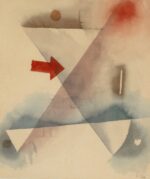
Blast
Mar 28 2024
“The Troop Leader” by Brynne Jones
BLAST, TMR’s online-only prose anthology, features prose too vibrant to be confined between the covers of a print journal. In Brynne Jones’s “The Troop Leader,” the adult chaperone of a… read more

Blast
Mar 15 2024
“Pete Pete’s Putt Putt Palace” by Adam Straus
BLAST, TMR’s online-only prose anthology, features prose too vibrant to be confined between the covers of a print journal. In “Pete Pete’s Putt Putt Palace,” Adam Straus tells the story… read more

